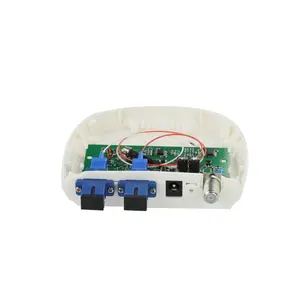Introduction to Wireless Optical Transmitter and Receiver
The wireless optical transmitter and receiver system is a groundbreaking advancement in the field of data transmission. Utilizing light waves to convey information, these devices eliminate the need for traditional wired connections, offering enhanced mobility and flexibility. With the ability to transmit high-quality video, audio, and data over considerable distances, wireless optical systems are rapidly becoming essential in various industrial and commercial settings.
Types of Wireless Optical Transmitter and Receiver
Wireless optical transmitters and receivers come in several types, tailored for different applications. Understanding the available options can help businesses choose the most effective solution for their needs:
- Single-Mode Optical Transmitter and Receiver: Ideal for long-distance transmission, providing low signal loss and high bandwidth.
- Multi-Mode Optical Transmitter and Receiver: Designed for short-distance applications, often used in local area networks (LANs).
- IrDA (Infrared Data Association) Transmitter and Receiver: Common in remote control devices and short-range communications.
- Visible Light Communication (VLC) Systems: Utilizes LED lighting to transmit data, suitable for indoor environments.
Function and Feature of Wireless Optical Transmitter and Receiver
The functionality of wireless optical transmitters and receivers is characterized by a variety of innovative features that enhance data transmission:
- High-Speed Data Transmission: Capable of transmitting data rates up to several gigabits per second, ensuring swift communication.
- Low Latency: Minimizes lag, making it ideal for real-time applications such as live broadcasting or gaming.
- Enhanced Security: Optical signals are confined to a line of sight, reducing risks of eavesdropping and unauthorized access.
- Simplicity of Installation: Typically requires minimal setup, making it easier to implement compared to traditional cabling systems.
Applications of Wireless Optical Transmitter and Receiver
Wireless optical transmitters and receivers find applications across various sectors, underscoring their versatility:
- Telecommunications: Used to connect trunk lines in urban settings, facilitating high-bandwidth services.
- Healthcare: Ideal for data transfer in hospitals where patient safety and data integrity are paramount.
- Aviation: Utilized for secure communications and data transfer between aircraft and ground systems.
- Education: Employed in classroom settings to project high-definition video and audio wirelessly.
- Event Production: Allows seamless transmission of media content during events, conferences, and exhibitions.
Advantages of Using Wireless Optical Transmitter and Receiver
The decision to implement a wireless optical transmitter and receiver system offers numerous advantages that contribute to operational efficiency:
- Mobility and Flexibility: Users can easily relocate devices without the constraints of physical cables.
- Cost-Effective Installations: Reduces installation costs associated with wiring infrastructure.
- Durability: Optical systems are less susceptible to electromagnetic interference, ensuring reliability in signal transmission.
- Eco-Friendly: Reduced reliance on copper and extensive wiring leads to a smaller carbon footprint.














































































































































































